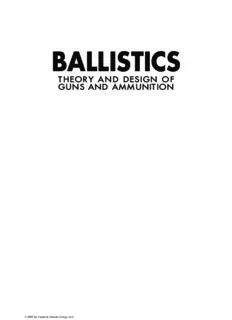
Ballistics. Theory and Design of Guns and Ammunition PDF
Preview Ballistics. Theory and Design of Guns and Ammunition
BALLISTICS THEORY AND DESIGN OF GUNS AND AMMUNITION (cid:1)2007byTaylor&FrancisGroup,LLC. (cid:1)2007byTaylor&FrancisGroup,LLC. BALLISTICS THEORY AND DESIGN OF GUNS AND AMMUNITION DONALD E. CARLUCCI SIDNEY S. JACOBSON Boca Raton London New York CRC Press is an imprint of the Taylor & Francis Group, an informa business (cid:1)2007byTaylor&FrancisGroup,LLC. The design, fabrication and use of guns, ammunition and explosives are, by their very nature, dangerous. The techniques, theories, and procedures developed in this book should not be utilized by anyone without the proper training and certi- fications. In the checking and editing of these techniques, theories, and procedures, every effort has been made to iden- tify potential hazardous steps, and safety precautions have been inserted where appropriate. However, these techniques, theories, and procedures must be exercised at one’s own risk. The authors and the publisher, its subsidiaries and distribu- tors, assume no liability and make no guarantees or warranties, express or implied, for the accuracy of the contents of this book or the use of information, methods or products described within. In no event shall the authors, the publisher, its subsidiaries or distributors be liable for any damages and expenses resulting from the use of information, methods, or products described in this book. CRC Press Taylor & Francis Group 6000 Broken Sound Parkway NW, Suite 300 Boca Raton, FL 33487-2742 © 2008 by Taylor & Francis Group, LLC CRC Press is an imprint of Taylor & Francis Group, an Informa business No claim to original U.S. Government works Printed in the United States of America on acid-free paper 10 9 8 7 6 5 4 3 2 1 International Standard Book Number-13: 978-1-4200-6618-0 (Hardcover) This book contains information obtained from authentic and highly regarded sources. Reprinted material is quoted with permission, and sources are indicated. A wide variety of references are listed. Reasonable efforts have been made to publish reliable data and information, but the author and the publisher cannot assume responsibility for the validity of all materials or for the consequences of their use. Except as permitted under U.S. Copyright Law, no part of this book may be reprinted, reproduced, transmitted, or uti- lized in any form by any electronic, mechanical, or other means, now known or hereafter invented, including photocopy- ing, microfilming, and recording, or in any information storage or retrieval system, without written permission from the publishers. For permission to photocopy or use material electronically from this work, please access www.copyright.com (http:// www.copyright.com/) or contact the Copyright Clearance Center, Inc. (CCC) 222 Rosewood Drive, Danvers, MA 01923, 978-750-8400. CCC is a not-for-profit organization that provides licenses and registration for a variety of users. For orga- nizations that have been granted a photocopy license by the CCC, a separate system of payment has been arranged. Trademark Notice: Product or corporate names may be trademarks or registered trademarks, and are used only for identification and explanation without intent to infringe. Library of Congress Cataloging-in-Publication Data Carlucci, Donald E. Ballistics : theory and design of guns and ammunition / by Donald E. Carlucci and Sidney S. Jacobson. p. cm. Includes bibliographical references and index. ISBN-13: 978-1-4200-6618-0 ISBN-10: 1-4200-6618-8 1. Ballistics. I. Jacobson, Sidney S. II. Title. UF820.C28 2008 623’.51--dc22 2007026359 Visit the Taylor & Francis Web site at http://www.taylorandfrancis.com and the CRC Press Web site at http://www.crcpress.com (cid:1)2007byTaylor&FrancisGroup,LLC. To PegC., Sandy J.,andourfamilies, without whose patience andsupport we couldnothave brought this work to completion (cid:1)2007byTaylor&FrancisGroup,LLC. (cid:1)2007byTaylor&FrancisGroup,LLC. Contents Preface Authors Acknowledgments Part I Interior Ballistics Chapter 1 Introductory Concepts 1.1 Ballistic Disciplines 1.2 Terminology 1.3 Units and Symbols Chapter 2 Physical Foundation of Interior Ballistics 2.1 The Ideal Gas Law 2.2 Other Gas Laws 2.3 Thermophysics and Thermochemistry 2.4 Thermodynamics 2.5 Combustion 2.6 Solid Propellant Combustion 2.7 Fluid Mechanics References Chapter 3 Analytic and Computational Ballistics 3.1 Computational Goal 3.2 Lagrange Gradient 3.3 Chambrage Gradient 3.4 Numerical Methods in Interior Ballistics 3.5 Sensitivities and Efficiencies References Chapter 4 Ammunition Design Practice 4.1 Stress and Strain 4.2 Failure Criteria 4.3 Ammunition Types 4.4 Propellant Ignition 4.5 The Gun Chamber 4.6 Propellant Charge Construction 4.7 Propellant Geometry 4.8 Cartridge Case Design 4.9 Projectile Design (cid:1)2007byTaylor&FrancisGroup,LLC. 4.10 Shell Structural Analysis 4.11 Buttress Thread Design 4.12 Sabot Design References Further Reading Chapter 5 Weapon Design Practice 5.1 Fatigue and Endurance 5.2 Tube Design 5.3 Gun Dynamics 5.4 Muzzle Devices and Associated Phenomena Gun Dynamics Nomenclature References Further Reading Part II Exterior Ballistics Chapter 6 Introductory Concepts References Further Reading Chapter 7 Dynamics Review Reference Further Reading Chapter 8 Trajectories 8.1 Vacuum Trajectory 8.2 Simple Air Trajectory (Flat Fire) 8.3 Wind Effects on a Simple Air Trajectory 8.4 Generalized Point Mass Trajectory 8.5 Six Degree-of-Freedom (6-DOF) Trajectory 8.6 Modified Point Mass Trajectory References Further Reading Chapter 9 Linearized Aeroballistics 9.1 Linearized Pitching and Yawing Motions 9.2 Gyroscopic and Dynamic Stabilities 9.3 Yaw of Repose 9.4 Roll Resonance References Chapter 10 Mass Asymmetries References Chapter 11 Lateral Throwoff 11.1 Static Imbalance 11.2 Dynamic Imbalance References (cid:1)2007byTaylor&FrancisGroup,LLC. Chapter 12 Swerve Motion 12.1 Aerodynamic Jump 12.2 Epicyclic Swerve 12.3 Drift Reference Chapter 13 Nonlinear Aeroballistics 13.1 Nonlinear Forces and Moments 13.2 Bilinear and Trilinear Moments References Part III Terminal Ballistics Chapter 14 Introductory Concepts Chapter 15 Penetration Theories 15.1 Penetration and Perforation of Metals 15.2 Penetration and Perforation of Concrete 15.3 Penetration and Perforation of Soils 15.4 Penetration and Perforation of Ceramics 15.5 Penetration and Perforation of Composites References Chapter 16 Shock Physics 16.1 Shock Hugoniots 16.2 Rarefaction Waves 16.3 Stress Waves in Solids 16.4 Detonation Physics References Further Reading Chapter 17 Introduction to Explosive Effects 17.1 Gurney Method 17.2 Taylor Angles 17.3 Mott Formula References Further Reading Chapter 18 Shaped Charges 18.1 Shaped Charge Jet Formation 18.2 Shaped Charge Jet Penetration References Further Reading Chapter 19 Wound Ballistics References Further Reading (cid:1)2007byTaylor&FrancisGroup,LLC. Appendix A. Glossary B. Tabulated Properties of Materials Further Reading (cid:1)2007byTaylor&FrancisGroup,LLC.
Description: